Once upon a time information was scarce, and communication sacred. Kids went to the library to research their projects, and people waited for letters to arrive.
Time warp, snap, cut to today, and we are in the age of information deluge, and perpetual distraction. One search would give you 100,000 potential resources; but you lack the patience to go beyond page 1.
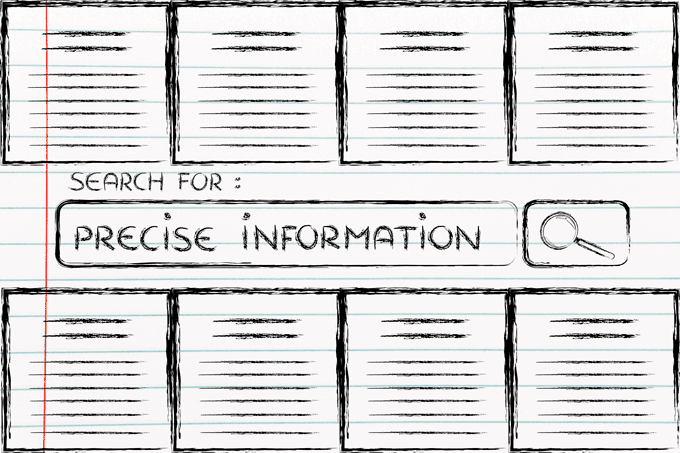
Heck, the answer to life, and all the existential questions you discussed last Friday might be buried somewhere in page 5 of search results, but it will remain there – buried, unless some kid discovers it, and reddits it. In which case, it would go viral.
Well, I barely belong to the generation of framed telegrams, but I do remember going to the library to research my 8th standard History project. And, if finding information was tough then, it’s way beyond tough now.
What I am just saying that there is an excess of content, and not many ways to filter out the junk. That’s probably the reason why people’s attention span is dropping, and not the other way around.
Are you just adding to the junk?
Not really, given you understand your target audience.
There are many businesses actually getting across to their target audience, and in many cases, without doing anything fancy. They just know their target audience, and provide content of real value to them. Let’s discuss a few content marketing tips that have proven successful for many businesses.
With any of these content strategies, remember that the starting point would be to find what your target audience is interested in, and what are their content consumption channels & devices of preference.
Strategy 1: Video Marketing
We are a lazy bunch. Did I already say that? If I did, I was talking about your target audience too, as subtly as possible. They want answers, but they want them without much effort.
Video marketing can really help you cut through the clutter in that case. And, I am not talking fancy, high cost videos either. I am talking small little things of value.
I personally know of many businesses doing this really well – many of them belong to education industry. And, they don’t do anything special either – they just record their online training sessions, and put up the snippets on YouTube to get attention of the searchers. And, most of these videos aren’t uber-cool, they are just valuable.
To reiterate the fact that a good video (movie, in this case) can get even the laziest of people interested in what you have to say, take a look at what the release of The Great Gatsby movie in 2013 did to the sale of Fitzgerald’s masterpiece.
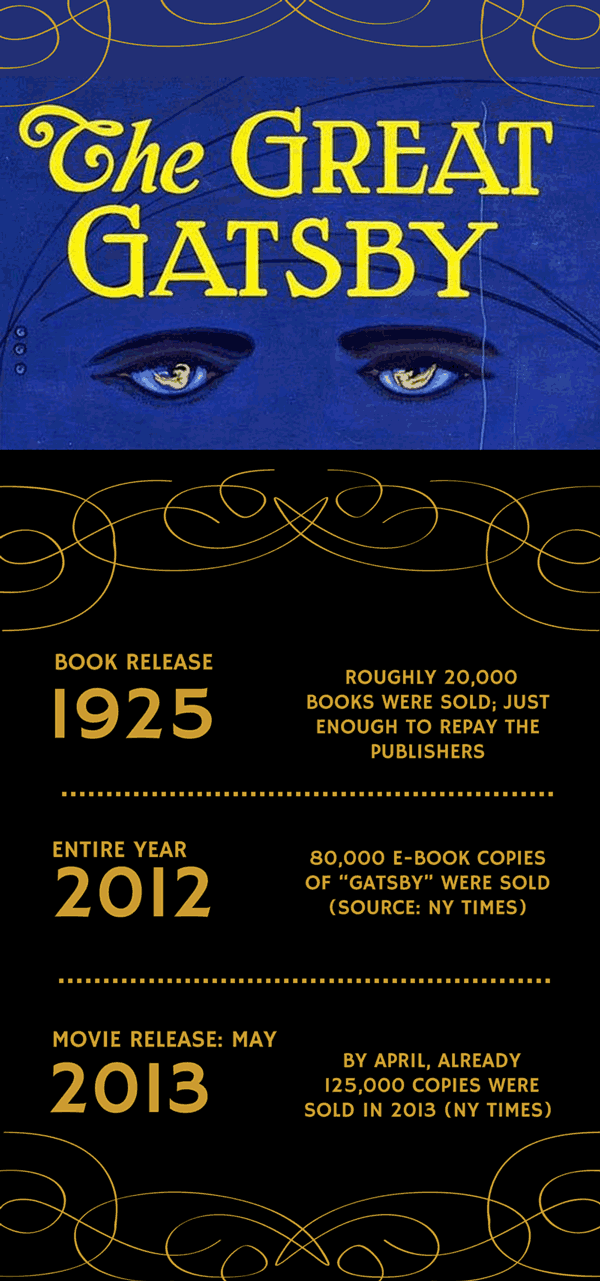
To quote another example, Lucky Strike, Donald Draper’s (Mad Men) preferred smoke, saw global sales grow 44 percent in the five years following Mad Men’s debut, per Ivey Business Review. (Source: AdAge)
Let’s dial the popular and the glamorous down a notch, and talk about regular businesses.
Education Businesses
Video tutorials are the way to go. If you have a business that requires creating videos as part of the course, you already are sitting on a goldmine.
a) Just upload your sessions on public websites, like YouTube and DailyMotion, and you would be getting free views in no time.
b) You can even create video testimonials during the exam seasons, or for your lead capture landing pages.
One great example of video marketing done right is Edureka, a technical skills training company that grew from a start-up to topping the Deloitte Fast 50 Awards for India in 2014.
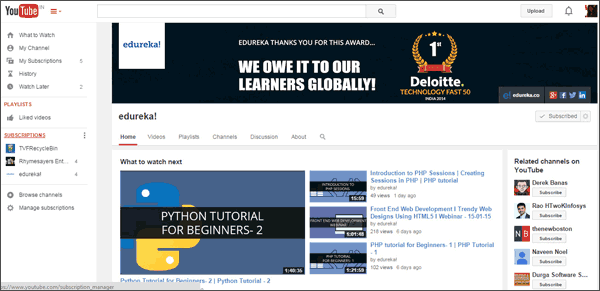
Their business
They provide technical skills training, like Hadoop and Big Data Analytics, Android Development etc. and their mode of education is webinars. There are far too many elements that have made their business successful, but effective video marketing is definitely one of them.
Their video strategy
One of their key strategies was to record their webinar sessions, and publish them on YouTube; people searching for their course-related terms would find the videos and therefore land upon Edureka’s complete courses. So, this is what they did:
1. They repurposed their content: They did not spend a fortune creating videos; they just repurposed their course content on YouTube
2. They chose the right channel (YouTube) to be discovered – YouTube videos tend to rank higher, because
- YouTube is Google’s property,
- People looking for learning resources online are looking for video tutorials.
- There is a separate video search tab on Google. It’s just easier for people.
3. They offered free webinars: Through that, they managed to catch their subscriber’s attentions, because they did it regularly and frequently (once a week, initially), and free training with a live trainer is something that always catches people’s attention, because they can get their questions answered.
Q/A section is the most popular part of our webinars as well.
4. High quality product gave them subscribers and loyal viewers: Because the content they created was high quality, people subscribed to their YouTube channel, and came back for more. They have 30,360 subscribers & 2,949,856 views on their channel now.
Travel Businesses
Travel has always been about selling a dream, an experience, no matter how small or how big the scale of a campaign is. But, how do you sell a dream on a small business’s marketing budget. You don’t have access to the same advertising resources as say “British Airways.”
a) If you can get an in-house video created, do it, and run ads on YouTube
b) If you lack the resources, source user generated content. Almost everyone documents their travel in the form of photographs and videos. Incentivize your clients for helping you out – give them a backpack, or some travel gear in return. This has become one of the most used ways to generate content and reach out to travel enthusiasts.
YouTube Ads
I will take an example from Google’s case study itself. The campaign was for Nassau Paradise Islands. This was the video ad that they used:
Target audience: residents of New York & South Florida
Marketing strategies that were being used before: Traditional brick and mortar tour operators, print media and some broadcast options whenever budgets permitted.
Chosen ad type: YouTube’s TrueView In-stream ads. These are the ads that play before a YouTube video begins, and viewers have an option to skip them after 5 seconds. The advertisers are charged for the view, only if the viewer watches the ad for 30 seconds or to the completion of the ad.
Results: They saw an average increase in website visits by 33% to 56%, and they were able to reduce cost per view from 15 cents to 11 cents. They also found that it took roughly 15 cents to get a highly qualified lead to engage with their video. This if done with a television commercial was completely unaffordable for them.
The campaign was a success and they took the campaign national after that. Their major cost was only getting the video created.
Health & Wellness and Retail
The health & lifestyle businesses can easily put together tips for make-up, fitness etc. to create videos of value. Get some v-loggers onboard if you lack the resources to do it yourself. Offer them one or an assortment of your packages in exchange, and if they like it, they would be happy to endorse you.
B2B
Here are a couple of stats for B2B searches from Thinkwithgoogle:
Most of the B2B searchers are millenials
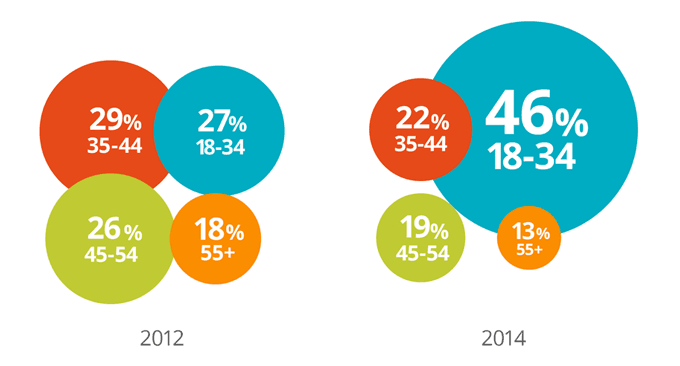
And, millenials watch videos.
According to U.S. YouTube data, over 895K hours of some of the top B2B videos from brands were watched in 2014. And these viewers are watching videos for longer time periods.
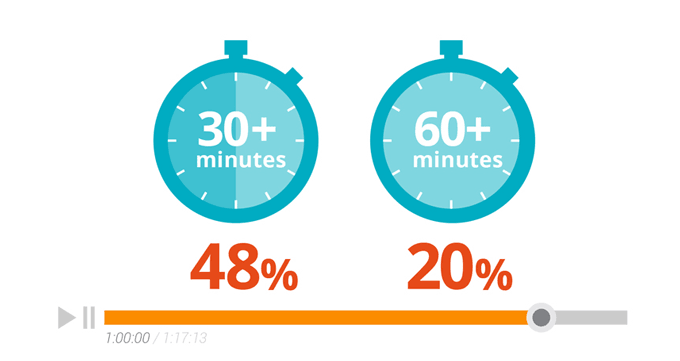
Training videos, product introduction videos, live webinars and webinar recordings – there’s a lot to do in B2B videos. Webinar, for one, has proven to be one of the best converting content for us, both in terms of capturing unique leads and landing page conversions (always upwards of 60%)
Strategy 2: Participate in user forums
This is one of those content marketing tips that we can personally vouch for. We engage in conversations regularly on Quora, and as a result get quite a bit of referral traffic from there, and these referrals are the stickiest ones.
To do this effectively, there are 2 things that you need to do:
a) Identify the forums you should interact with your clients on
- Quora would work well across different industries.
- Yahoo Answers has worked well for a few of our Education clients. You can find specific student forums to participate in as well.
- Travel – Sites like TripAdvisor would be a good place to start
- LinkedIn would work well for B2B companies. Many higher education courses, like Executive MBA businesses would also find success on LinkedIn
b) Share things of value
Remember that you aren’t there to spam. Participate in discussions, and share your insights.
I’ll share an example of a travel business doing well on this aspect:
“Old World Napa Inn” on TripAdvisor
Their Strategy
Post helpful answers to user queries on TripAdvisor. “The Innkeepers” are everywhere sharing helpful answers on the topics of their location, thus garnering credibility, and visibility
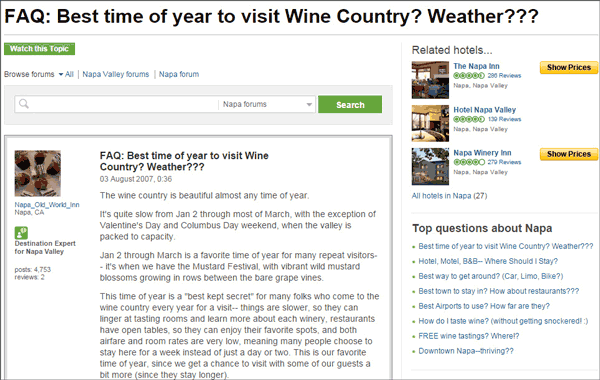
Why would this absolutely work?
- 70% travelers look up to 20 reviews before booking a trip. Most of this is done on TripAdvisor and Google Reviews.
- When these travelers see a hotel or a travel agent being proactive in sharing their advice, it builds credibility in their minds.
See how regular they are in this exercise:
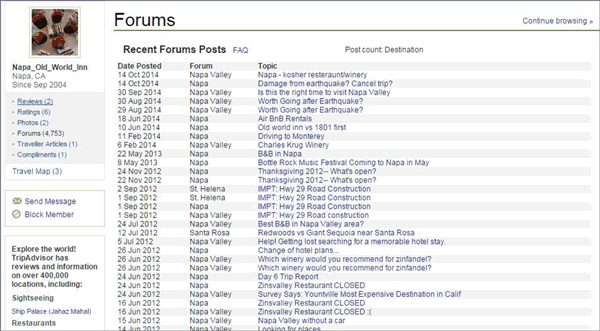
Strategy 3: Implement a lead nurturing strategy
One important thing that many businesses forget is the keeping those leads engaged who would not buy immediately.
For these leads, you need to set up a proper lead engagement or nurturing process. And, you have to remember that you cannot send the same random content to everyone in your system. This is when the need of a smart segmentation and marketing automation system also becomes very important.
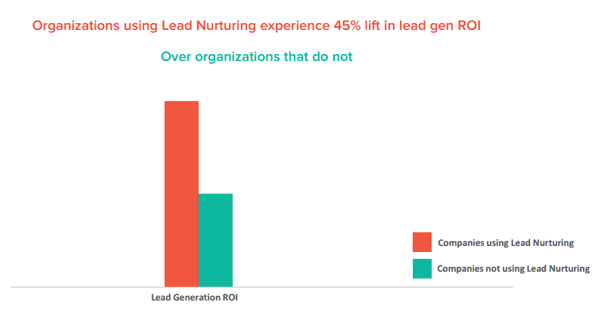
(Source: MarketingSherpa)
There are 3 steps here that would lead your strategy:
a) Audience segmentation
b) Persona creation
c) Content sharing based on the segments and personas
a) Audience segmentation
There are 2 ways you can segment the leads that come into your system:
Segmentation by tracking
You identify your prospects’ demographics & interests by recording and tracking their web activities.
Segment by asking upfront
Despite having tracking systems in place, many businesses also ask their subscribers upfront about the kind of content they would like to receive.
This would be relevant if you sell or write about a lot of different things. Activity tracking would give you an idea about what exactly the prospects are interested in, but asking them if they would like updates about something else might also uncover an interest that hasn’t been identified yet.
b) Persona creation
Creating personas of your prospective buyers would help you understand their motivations and concerns and would help you create content that’s spot-on, and share it through channels they would appreciate.
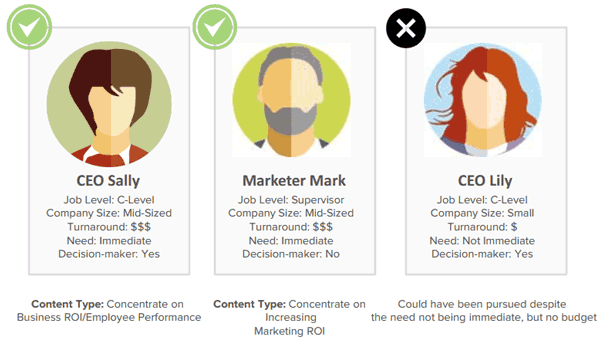
Creating personas might sound painful at first, but it would definitely give you an idea of what would be the most relevant to your audience. Also, it would be a great advantage, if you are dealing with a large number of leads. This is one app that you can use to create personas.
I’ll take an example of a client from education industry who had segmented his audience into 3 classes based on their behavior:
- Students who exactly know what they want – they have done their research, and are sure about what they want to buy. Any attempt at cross-selling or up-selling to them might lead to them dropping the purchase idea completely.
- Students who need some guidance in choosing between a few options.
- Students who want to be led through to understand what course is the best for them. These students need counsellor like attention from sales people. This is the kind of audience you need to assume a guide kind of a role, and besides counselling by sales team, you need to send them documents that would help make their decisions easier.
Similar manner, you can do this for your business, B2B or B2C. Here are a few attributes that would help you create personas for your business.
B2C Persona Definition attributes
- Age
- Gender
- Geography
- Household Income
- Education Qualification
- Family Status
- Motivations
- Technology used to access internet – web, mobile etc.
- Research Sources – Blog Articles, Social (Lead Source can tell you more about this)
- Concerns, Fears, Pain-points
B2B Persona Definition attributes
- Job Level
- Company Size
- Company Turnaround
- Industry
- Education Qualification
- Purchase Urgency
- Goals and Motivations
- Technology used to access internet – web, mobile etc.
- Research Sources – Blog Articles, Social (Lead Source can tell you more about this)
- Concerns, Fears, Pain-points
What will the persona definition tell you?
- What topics to choose for nurturing
- What format of nurturing content is preferred by your audience (blogs, e-books, podcasts)
- Technology through which the content will be consumed (mobile, desktops, tablets)
- Platform/Channels on which the content will be consumed
c) Relevant Content Sharing
If you want a very simple example of an effective lead engagement strategy, consider this.
You might be a travel company trying to sell different tour packages.
You cannot send a General “World Travel Guide” to someone that specifically indicated interest in “Australia Tour Packages.” You should send them something like “Australia Tour Details.” So, it’s all about staying relevant.
Strategy 4: Responsiveness
There has been a consistent growth in content being consumed using smartphones, no matter what your industry. Here are some stats from Thinkwithgoogle for the use of smartphones in a B2B purchase cycle:
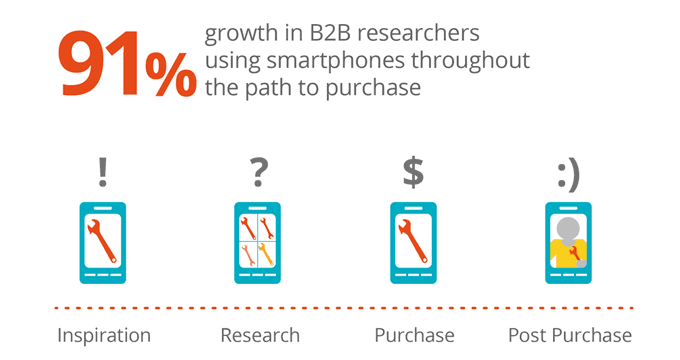
The trend is consistent across B2C businesses as well. This clearly shows you that you need all your content to be consumable on mobile devices to have it read and shared.
Majority of our blog shares also come through mobile. You can use AddThis on your blog to add sharing buttons and track the sharing patterns of your content.
I’ll take an example of how responsiveness can really help your business.
After clothing brand O’Neill went the responsive way for their website, they saw an immense increase the goal completion and overall revenue from their website. (Source: ElectricPulp)

For iOS
- Total Conversions increased by 65.71%
- Transactions augmented by 112.50%
- Revenue went up by 101.25%
For Android
- Conversions augmented by 407.32%
- Transactions increased by 333.33%
- Revenue increased by a mammoth 591.42%
So, if you are not responsive (or mobile friendly in some way yet), you should be. You also have to consider Google’s mobile-friendly algorithm update, if you get traffic from mobile.
Strategy 5: Contests
I have kept this one for last because I know they aren’t always easy to get the hang of. There are many things to consider before you can actually run a successful contest.
1. Identify the best channel to run the contest based on your audience.
2. Build a following on the said channel to get enough participation.
3. Invest on promoting the contest: You would of course put some money on getting the contest running, and you can get your email subscribers onboard that particular channel by getting them exited for it. However, to really reach new people, you would need to reach people who actually have some followers on the particular channel to participate in or at least endorse the contest.
4. You need to identify what content prize would appeal to your target audience.
5. Identify the audience to target with these contests: Now, like Deltin’s Marketing Wizard, Floyd said in our last webinar, sometimes your actual target audience would not share your content, because even though they are on these social platforms, they are more or less the silent spectators.
So, you should target the age-group that’s more likely to brag about an experience that they had, or look forward to having. And, your actual target audience would come to know about you, when these people participate in or share your contests.
One of the industries where it’s easiest to run contests is Travel. Because, once again, people like to talk about it, so it has more of a propensity of getting shared than other things.
I’ll give you an example of a successful Pinterest contest that JetSetter ran.
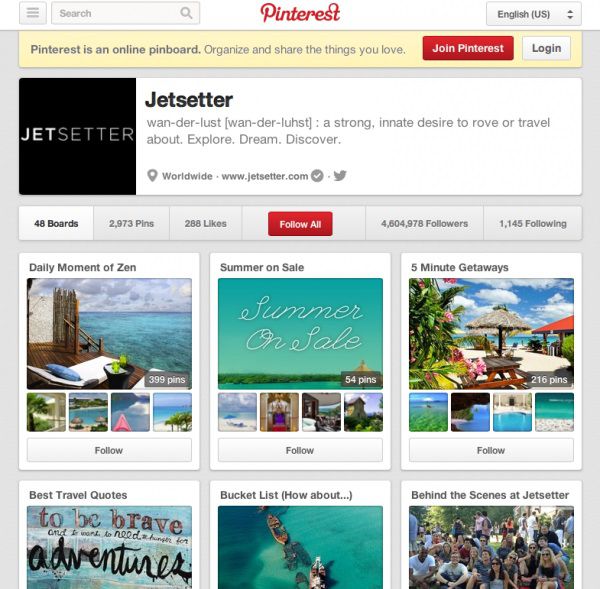
Aim
To improve traffic to the website and increase stickiness
What the contest participants needed to do?
People were invited to create “The ultimate destination pinboard”, across several categories, like escape, adventure etc., with relevant pictures. The winners would get to be JetSetter Curators, meaning they would be sent to dream destinations under the category of their choosing.
Outcome
During the campaign, the page views on JetSetter increased 150%, the referral traffic via Pinterest increased 100%, and the bounce rate decreased by 10-15%.
(Source: Mashable)
So, what do you need to do?
- Companies like Travel, Health and Wellness, and wherever visual content can play a role can choose platforms like Instagram, Pinterest etc.
- Education companies can use Facebook contests or even YouTube, Twitter and Vine
- Be active on your contest platform of interest for some time – Facebook, Pinterest, Instagram, Twitter and get some followers first, before you actually run a contest.
So, these were 5 content marketing tips that businesses can and should implement in their content strategy 2015. There are tons more, and I would continue sharing them in subsequent posts. Till then, tell us in comments what content type has worked the best for you.
Update : It’s almost 2016! And we’ve got a little gift for you to begin the new year on a productive note – a free, exhaustive and super-handy blog promotion checklist. Hope it helps :)









